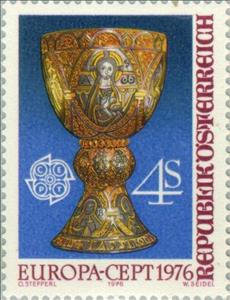Stamp: Tassilo Chalice, Kremsmünster Abbey (Austria 1976)
Tassilo Chalice, Kremsmünster Abbey (Austria 1976)
13 August (Austria ) within release C.E.P.T. goes into circulation Stamp Tassilo Chalice, Kremsmünster Abbey face value 4 Austrian schilling
| Stamp Tassilo Chalice, Kremsmünster Abbey in catalogues | |
|---|---|
| Michel: | Mi:AT 1516 |
| Yvert et Tellier: | Yt:AT 1345 |
Stamp is vertical format.
The Tassilo Chalice is a bronze chalice, gilded with silver and gold, dating from the 8th century. The chalice is of Anglo-Saxon design, and has probably been at Kremsmünster Abbey, Austria since shortly after it was made.Stamp Tassilo Chalice, Kremsmünster Abbey it reflects the thematic directions:
The European Conference of Postal and Telecommunications Administrations (CEPT) was established on June 26, 1959, as a coordinating body for European state telecommunications and postal organizations. The acronym comes from the French version of its name Conférence européenne des administrations des postes et des télécommunications.
Art is a diverse range of human activities in creating visual, auditory or performing artifacts (artworks), expressing the author's imaginative or technical skill, intended to be appreciated for their beauty or emotional power. In their most general form these activities include the production of works of art, the criticism of art, the study of the history of art, and the aesthetic dissemination of art. The oldest documented forms of art are visual arts, which include creation of images or objects in fields including painting, sculpture, printmaking, photography, and other visual media. Architecture is often included as one of the visual arts; however, like the decorative arts, or advertising, it involves the creation of objects where the practical considerations of use are essential—in a way that they usually are not in a painting, for example. Music, theatre, film, dance, and other performing arts, as well as literature and other media such as interactive media, are included in a broader definition of art or the arts. Until the 17th century, art referred to any skill or mastery and was not differentiated from crafts or sciences. In modern usage after the 17th century, where aesthetic considerations are paramount, the fine arts are separated and distinguished from acquired skills in general, such as the decorative or applied arts.
A craft or trade is a pastime or an occupation that requires particular skills and knowledge of skilled work. In a historical sense, particularly the Middle Ages and earlier, the term is usually applied to people occupied in small scale production of goods, or their maintenance, for example by tinkers. The traditional term craftsman is nowadays often replaced by artisan and by craftsperson.




